1986 TOYOTA CAMRY V20 check oil
[x] Cancel search: check oilPage 2319 of 2389
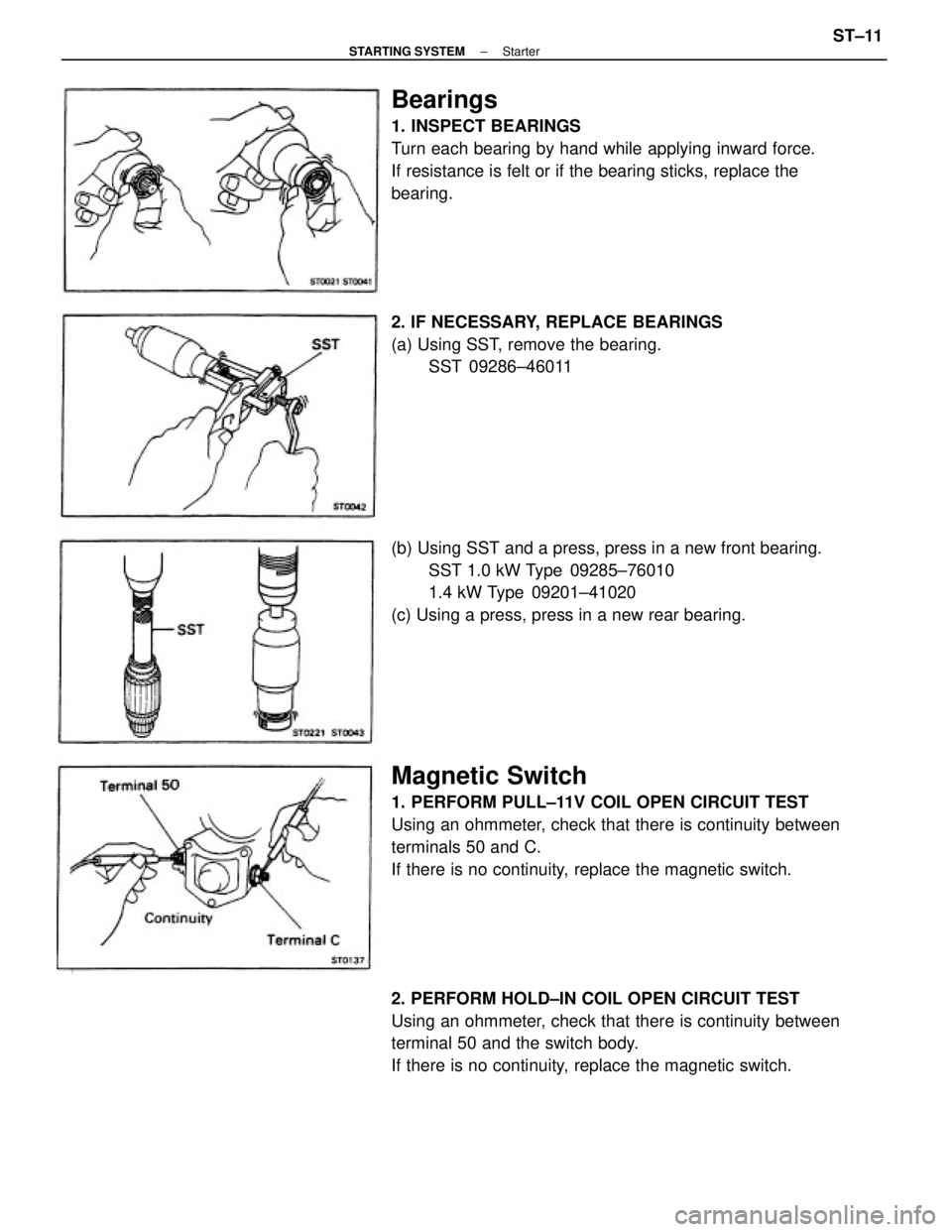
Bearings
1. INSPECT BEARINGS
Turn each bearing by hand while applying inward force.
If resistance is felt or if the bearing sticks, replace the
bearing.
Magnetic Switch
1. PERFORM PULL±11V COIL OPEN CIRCUIT TEST
Using an ohmmeter, check that there is continuity between
terminals 50 and C.
If there is no continuity, replace the magnetic switch.
2. PERFORM HOLD±IN COIL OPEN CIRCUIT TEST
Using an ohmmeter, check that there is continuity between
terminal 50 and the switch body.
If there is no continuity, replace the magnetic switch. (b) Using SST and a press, press in a new front bearing.
SST 1.0 kW Type 09285±76010
1.4 kW Type 09201±41020
(c) Using a press, press in a new rear bearing. 2. IF NECESSARY, REPLACE BEARINGS
(a) Using SST, remove the bearing.
SST 09286±46011
± STARTING SYSTEMStarterST±11
Page 2322 of 2389
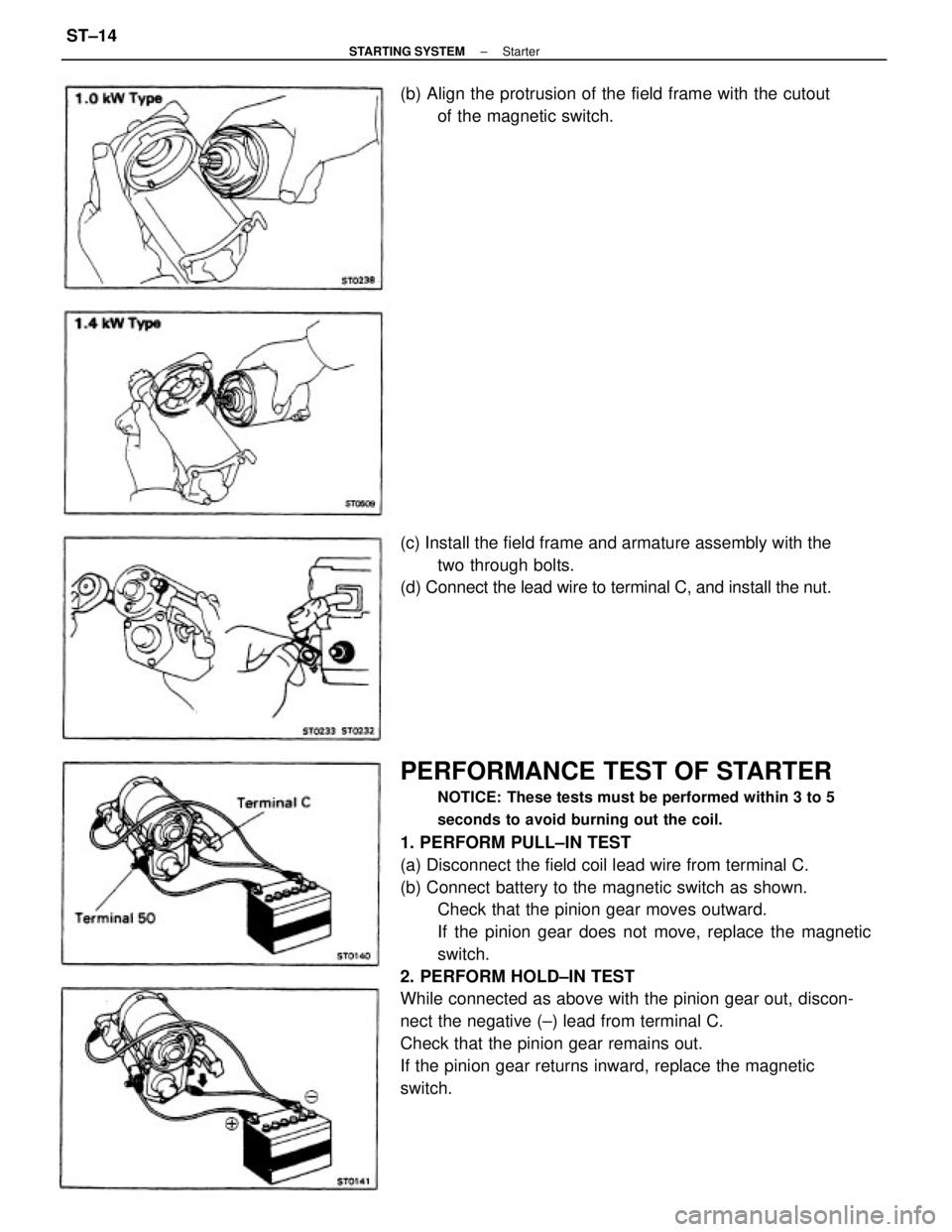
PERFORMANCE TEST OF STARTER
NOTICE: These tests must be performed within 3 to 5
seconds to avoid burning out the coil.
1. PERFORM PULL±IN TEST
(a) Disconnect the field coil lead wire from terminal C.
(b) Connect battery to the magnetic switch as shown.
Check that the pinion gear moves outward.
If the pinion gear does not move, replace the magnetic
switch.
2. PERFORM HOLD±IN TEST
While connected as above with the pinion gear out, discon-
nect the negative (±) lead from terminal C.
Check that the pinion gear remains out.
If the pinion gear returns inward, replace the magnetic
switch. (c) Install the field frame and armature assembly with the
two through bolts.
(d) Connect the lead wire to terminal C, and install the nut. (b) Align the protrusion of the field frame with the cutout
of the magnetic switch.
± STARTING SYSTEMStarterST±14
Page 2323 of 2389
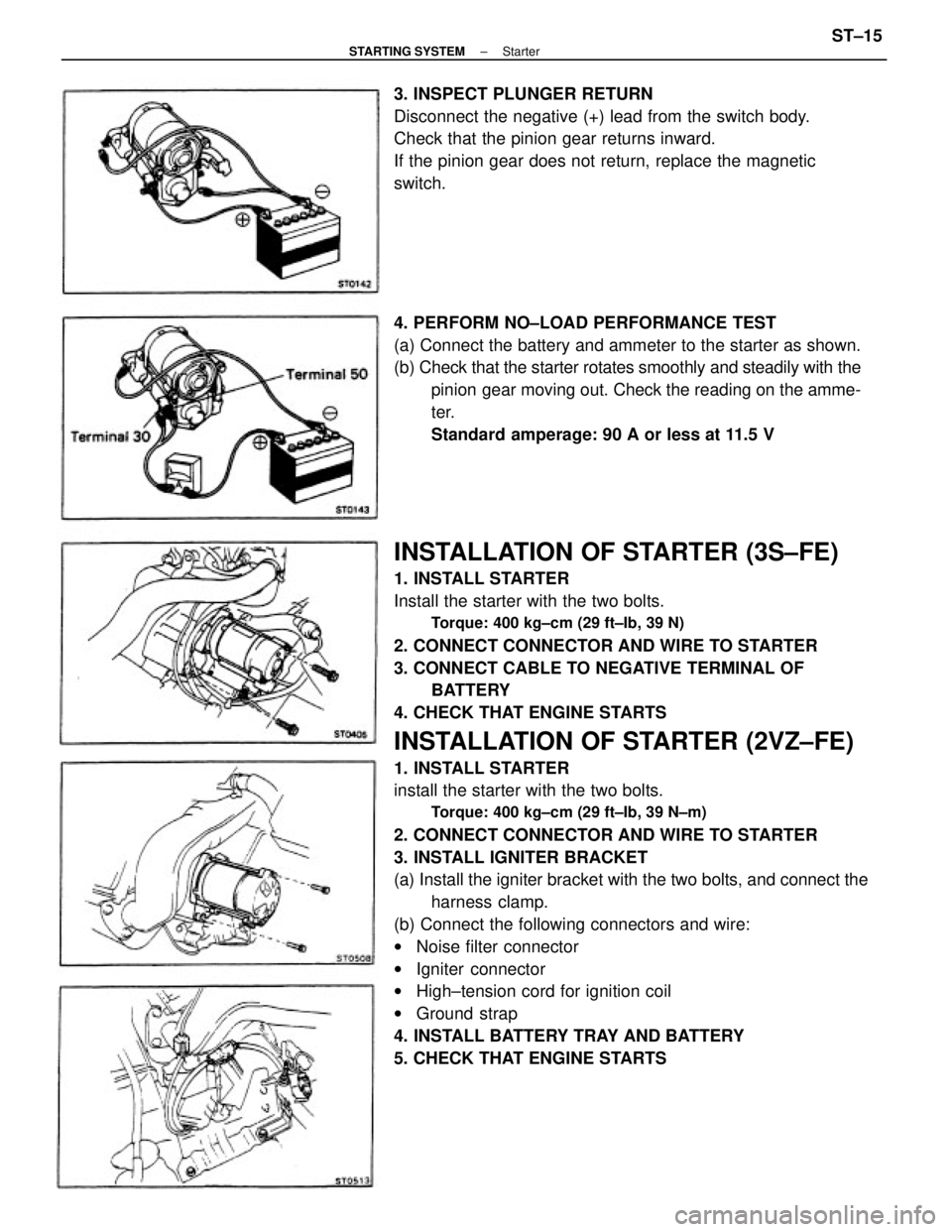
INSTALLATION OF STARTER (3S±FE)
1. INSTALL STARTER
Install the starter with the two bolts.
Torque: 400 kg±cm (29 ft±Ib, 39 N)
2. CONNECT CONNECTOR AND WIRE TO STARTER
3. CONNECT CABLE TO NEGATIVE TERMINAL OF
BATTERY
4. CHECK THAT ENGINE STARTS
INSTALLATION OF STARTER (2VZ±FE)
1. INSTALL STARTER
install the starter with the two bolts.
Torque: 400 kg±cm (29 ft±Ib, 39 N±m)
2. CONNECT CONNECTOR AND WIRE TO STARTER
3. INSTALL IGNITER BRACKET
(a) Install the igniter bracket with the two bolts, and connect the
harness clamp.
(b) Connect the following connectors and wire:
wNoise filter connector
wIgniter connector
wHigh±tension cord for ignition coil
wGround strap
4. INSTALL BATTERY TRAY AND BATTERY
5. CHECK THAT ENGINE STARTS 4. PERFORM NO±LOAD PERFORMANCE TEST
(a) Connect the battery and ammeter to the starter as shown.
(b) Check that the starter rotates smoothly and steadily with the
pinion gear moving out. Check the reading on the amme-
ter.
Standard amperage: 90 A or less at 11.5 V 3. INSPECT PLUNGER RETURN
Disconnect the negative (+) lead from the switch body.
Check that the pinion gear returns inward.
If the pinion gear does not return, replace the magnetic
switch.
± STARTING SYSTEMStarterST±15
Page 2336 of 2389
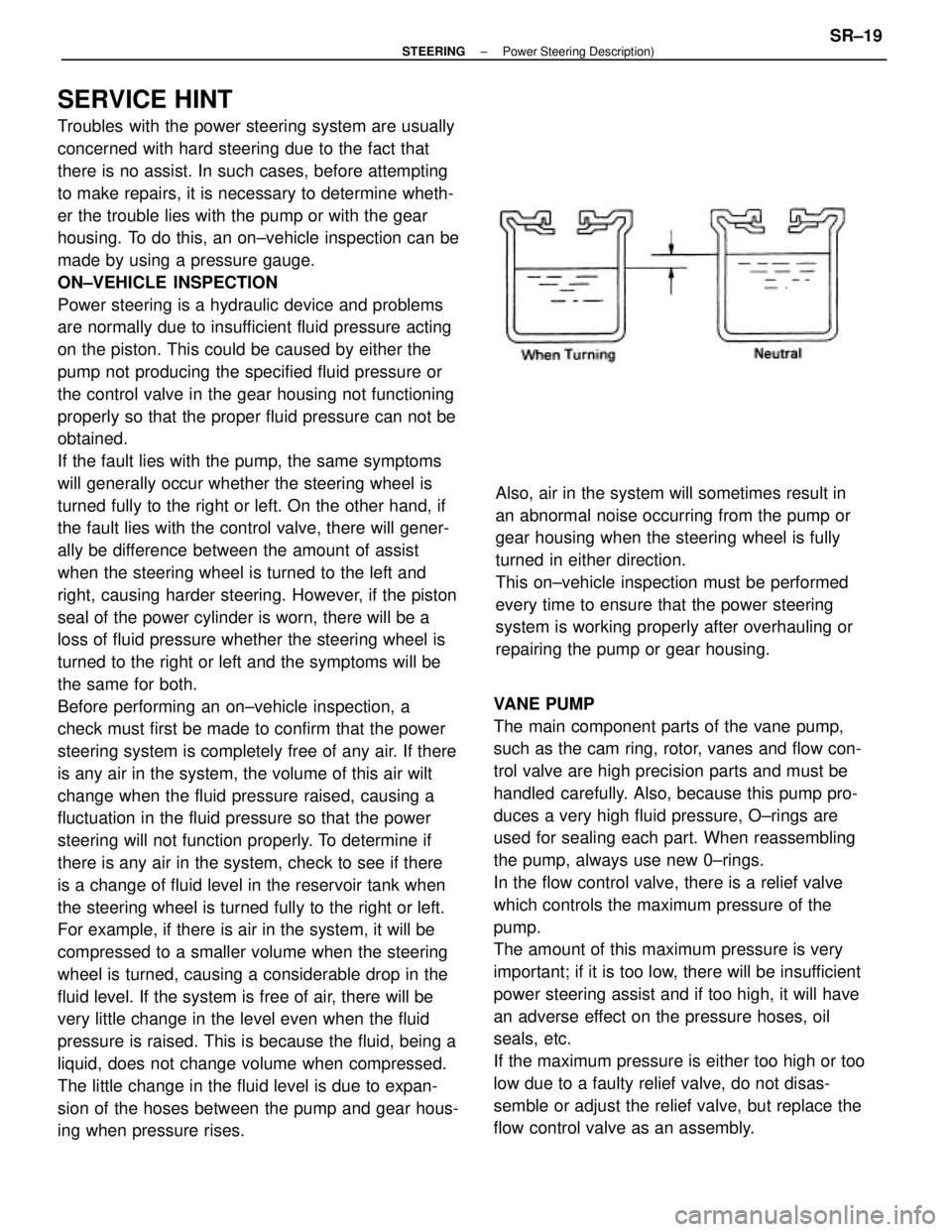
SERVICE HINT
Troubles with the power steering system are usually
concerned with hard steering due to the fact that
there is no assist. In such cases, before attempting
to make repairs, it is necessary to determine wheth-
er the trouble lies with the pump or with the gear
housing. To do this, an on±vehicle inspection can be
made by using a pressure gauge.
ON±VEHICLE INSPECTION
Power steering is a hydraulic device and problems
are normally due to insufficient fluid pressure acting
on the piston. This could be caused by either the
pump not producing the specified fluid pressure or
the control valve in the gear housing not functioning
properly so that the proper fluid pressure can not be
obtained.
If the fault lies with the pump, the same symptoms
will generally occur whether the steering wheel is
turned fully to the right or left. On the other hand, if
the fault lies with the control valve, there will gener-
ally be difference between the amount of assist
when the steering wheel is turned to the left and
right, causing harder steering. However, if the piston
seal of the power cylinder is worn, there will be a
loss of fluid pressure whether the steering wheel is
turned to the right or left and the symptoms will be
the same for both.
Before performing an on±vehicle inspection, a
check must first be made to confirm that the power
steering system is completely free of any air. If there
is any air in the system, the volume of this air wilt
change when the fluid pressure raised, causing a
fluctuation in the fluid pressure so that the power
steering will not function properly. To determine if
there is any air in the system, check to see if there
is a change of fluid level in the reservoir tank when
the steering wheel is turned fully to the right or left.
For example, if there is air in the system, it will be
compressed to a smaller volume when the steering
wheel is turned, causing a considerable drop in the
fluid level. If the system is free of air, there will be
very little change in the level even when the fluid
pressure is raised. This is because the fluid, being a
liquid, does not change volume when compressed.
The little change in the fluid level is due to expan-
sion of the hoses between the pump and gear hous-
ing when pressure rises.VANE PUMP
The main component parts of the vane pump,
such as the cam ring, rotor, vanes and flow con-
trol valve are high precision parts and must be
handled carefully. Also, because this pump pro-
duces a very high fluid pressure, O±rings are
used for sealing each part. When reassembling
the pump, always use new 0±rings.
In the flow control valve, there is a relief valve
which controls the maximum pressure of the
pump.
The amount of this maximum pressure is very
important; if it is too low, there will be insufficient
power steering assist and if too high, it will have
an adverse effect on the pressure hoses, oil
seals, etc.
If the maximum pressure is either too high or too
low due to a faulty relief valve, do not disas-
semble or adjust the relief valve, but replace the
flow control valve as an assembly.Also, air in the system will sometimes result in
an abnormal noise occurring from the pump or
gear housing when the steering wheel is fully
turned in either direction.
This on±vehicle inspection must be performed
every time to ensure that the power steering
system is working properly after overhauling or
repairing the pump or gear housing.
± STEERINGPower Steering Description)SR±19
Page 2337 of 2389
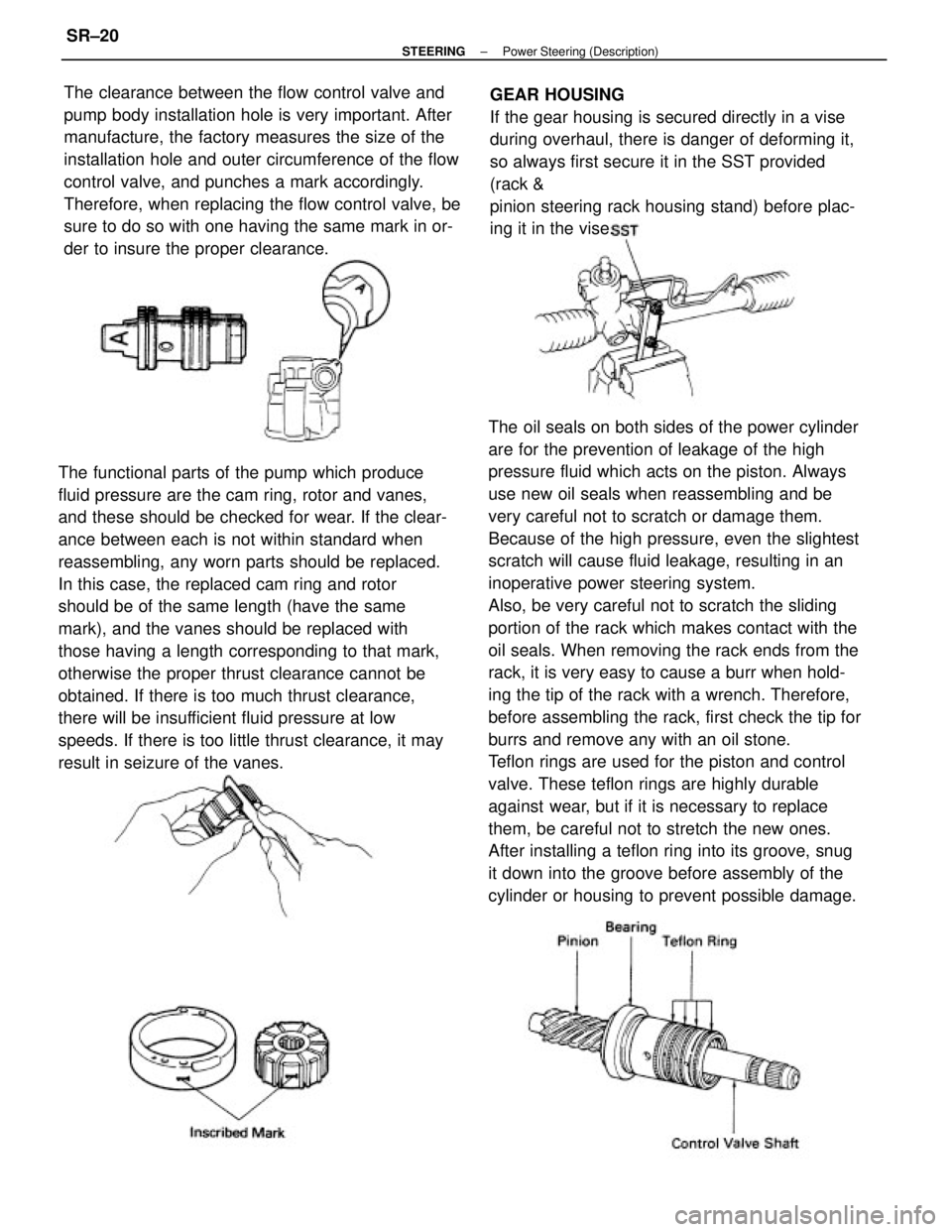
The oil seals on both sides of the power cylinder
are for the prevention of leakage of the high
pressure fluid which acts on the piston. Always
use new oil seals when reassembling and be
very careful not to scratch or damage them.
Because of the high pressure, even the slightest
scratch will cause fluid leakage, resulting in an
inoperative power steering system.
Also, be very careful not to scratch the sliding
portion of the rack which makes contact with the
oil seals. When removing the rack ends from the
rack, it is very easy to cause a burr when hold-
ing the tip of the rack with a wrench. Therefore,
before assembling the rack, first check the tip for
burrs and remove any with an oil stone.
Teflon rings are used for the piston and control
valve. These teflon rings are highly durable
against wear, but if it is necessary to replace
them, be careful not to stretch the new ones.
After installing a teflon ring into its groove, snug
it down into the groove before assembly of the
cylinder or housing to prevent possible damage. The functional parts of the pump which produce
fluid pressure are the cam ring, rotor and vanes,
and these should be checked for wear. If the clear-
ance between each is not within standard when
reassembling, any worn parts should be replaced.
In this case, the replaced cam ring and rotor
should be of the same length (have the same
mark), and the vanes should be replaced with
those having a length corresponding to that mark,
otherwise the proper thrust clearance cannot be
obtained. If there is too much thrust clearance,
there will be insufficient fluid pressure at low
speeds. If there is too little thrust clearance, it may
result in seizure of the vanes.The clearance between the flow control valve and
pump body installation hole is very important. After
manufacture, the factory measures the size of the
installation hole and outer circumference of the flow
control valve, and punches a mark accordingly.
Therefore, when replacing the flow control valve, be
sure to do so with one having the same mark in or-
der to insure the proper clearance.GEAR HOUSING
If the gear housing is secured directly in a vise
during overhaul, there is danger of deforming it,
so always first secure it in the SST provided
(rack &
pinion steering rack housing stand) before plac-
ing it in the vise.
± STEERINGPower Steering (Description)SR±20
Page 2351 of 2389

4. CHECK FLUID PRESSURE READING WITH VALVE
CLOSED
Close the pressure gauge valve and observe the reading
on the gauge.
Minimum pressure:
(VZV series) 75 kg/crn
2 (1,067 psi, 7,355 kPa)
(Others) 65 kg /crm
2 (924 psi, 6,374 kPa)
NOTICE:
wDo not keep the valve closed for more than 10
seconds.
wDo not let the fluid temperature become too high.
If pressure is low, repair or replace the PS pump.
5. OPEN VALVE FULLY .
6. CHECK AND RECORD PRESSURE READING AT
1,000 RPM
7. CHECK AND RECORD PRESSURE READING AT
3,000 RPM
Check that there is 5 kg /cm
2 (71 psi, 490 kPa) or less differ-
ence in pressure between the 1,000 rpm and 3, rpm
checks.
If the difference is excessive, repair or replace the flow con-
trol valve of the PS pump.(b) Connect the gauge side of the pressure gauge to the
PS pump, and the valve side to the pressure line.
(c) Bleed the system. Start the engine and turn the steer-
ing wheel from lock to lock two or three times.
(d) Check that the fluid level is correct.
OIL PRESSURE CHECK
1. CONNECT PRESSURE GAUGE
(a) Using SST, disconnect the pressure line joint.
SST 09631±22020
2. CHECK THAT FLUID TEMPERATURE IS AT LEAST
80
°C (176°F)
3. START ENGINE AND RUN IT AT IDLE
± STEERINGPower Steering (On±Vehicle Inspection)SR±25
Page 2363 of 2389

INSPECTION OF POWER STEERING
PUMP
1. MEASURE OIL CLEARANCE OF SHAFT AND BUSH-
ING
Using a micrometer and calipers, measure the oil clear-
ance.
Standard clearance: 0.01 = 0.03 mm
(0.0004 ± 0.0012 in.)
Maximum clearance: 0.07 mm (0.O028 in.)
If more than maximum, replace the entire power steering
pump.
2. INSPECT ROTOR AND VANE PLATES
(a) Using a micrometer, measure the height, thickness
and length of the vane plates.
Minimum height: 8.0 mm (0.315 in.)
Minimum thickness: 1.77 mm (0.0697 in.)
Minimum length: 14.97 mm (0.5894 in.)
(b) Using a feeler gauge, measure the clearance be-
tween the rotor groove and vane plate.
Maximum clearance: 0.03 mm (0.0012 in.)
If more than maximum, replace the vane plate and/or rotor
with one having the same mark stamped on the cam ring.
Inscribed mark: 1,2,3,4 or None
HINT: There are five vane lengths with the following ro-
tor and cam ring marks:
3. INSPECT FLOW CONTROL VALVE
(a) Coat the valve with power steering fluid and check
that it falls smoothly into the valve hole by its own
weight.
Rotor and cam
ring markVane lengthmm (in.)
± STEERINGPower Steering (Power Steering Pump)SR±37
Page 2364 of 2389
![TOYOTA CAMRY V20 1986 Service Information (b) Check the flow control valve for leakage.
Close.one of the holes and apply compressed air [4
±5 kg/crn
2 (57 ± 71 psi, 392 ± 490 kPa)] into the oppo-
site side, and confirm that air does not c TOYOTA CAMRY V20 1986 Service Information (b) Check the flow control valve for leakage.
Close.one of the holes and apply compressed air [4
±5 kg/crn
2 (57 ± 71 psi, 392 ± 490 kPa)] into the oppo-
site side, and confirm that air does not c](/manual-img/14/57449/w960_57449-2363.png)
(b) Check the flow control valve for leakage.
Close.one of the holes and apply compressed air [4
±5 kg/crn
2 (57 ± 71 psi, 392 ± 490 kPa)] into the oppo-
site side, and confirm that air does not come out from
the end hole.
4. INSPECT FLOW CONTROL SPRING
Using a scale, measure the free length of the spring.
Spring length: 36 ± 38 mm (1.42 ± 1.49 in.)
If not within specification, replace the spring. If necessary, replace the valve with one having the
same letter as inscribed on the front housing.
Inscribed mark: A,6,C,6, E or F
5. IF NECESSARY, REPLACE OIL SEAL
A
(a) Using a screwdriver, pry out the oil seal.
(b) Using a socket wrench and hammer, drive in a new
oil seal.
± STEERINGPower Steering (Power Steering PumpSR±38